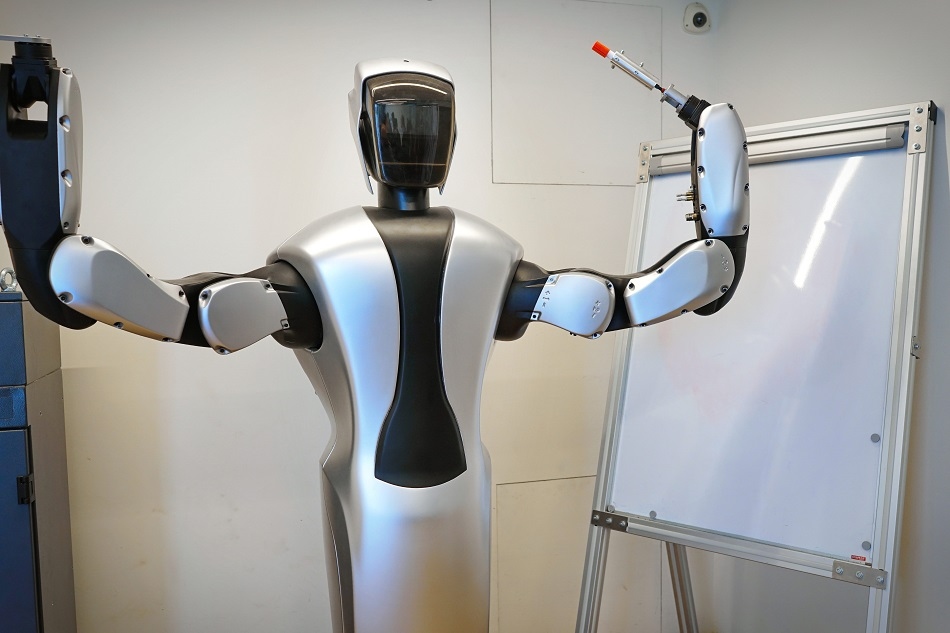Aug 13 2012

Image Credit: MikeDotta/Shutterstock.com
Child cognitive development has become an interest among researchers wanting to unravel the secrets behind children’s interaction with other people and how such interaction helps with their ability to communicate and learn with their peers. The continuous rise of technology has sparked research interests on the application of robotics in education, particularly in academic development and learning. At the beginning of the contemporary era of robotics, the biggest obstacle among researchers of personal robotics was developing technologies to interact with humans. This form of communication would only be possible with a robot that has all of the sensory elements required for a complex dialogue exchange with humans. In recent years, this development has been successfully achieved.
One effort to observe children’s interaction with one another and explore their capacity for learning and development involves the implementation of robotic teachers into school classrooms. In a pioneer study, a team of researchers at the National Science Foundation project and the University of Southern California worked on the development of robots that could aid cognitive, social, and emotional development in children with disabilities. The aim of the study was to create robots that can engage in a deeper level of cognitive interaction and to be able to learn from their own experiences so that they can understand personality traits and identify social cues.
Researches on Robot Teachers
In 2011, an international agency called Latitude teamed up with the LEGO Learning Institute and Project Synthesis to conduct a multi-phase innovation study that involved instructing children from across the globe to communicate (in the form of pictures and word) what it meant to have robots as part of everyday life. A total of 348 children, aged 8-12 years from all over the world, were asked to imagine their lives with robots inhabiting their learning and playtime and their outside of learning hours.
It was found that 64 percent of children described robots to be natural and human-like companions. When considering robots as integrated circuits, 20% saw robots as part of their peer groups. Only 28% related to robots as if they were like humans. Finally, there was a balance between children who wanted a robot to play with (38%) and those children who wanted a robot to learn with (38%).
Interactive robots are designed to be voice and touch-sensitive to increase the level of personalization with such technology and encourage intimacy, communication, and semantic learning between the child and robot. One point to highlight from this study was the large number of children reporting the robot as a human-like companion, which supports the suggestion of in-classroom robots to encourage learning and creativity among students. This finding also indicates that, when understanding human-robot interaction from a child’s mind, the robot would not harness any judgment for a child’s learning ability, demonstrating the need to create a humanoid teaching robot that can display a friendly and welcoming attitude to increase the chances of trust during the introductory phase of communication between the two entities. The results of this study have thus guided newer researches and technologies towards developing robots in education.
Application of Robot Teachers in the Classroom
In Japan, humanoid robots have been used in the classroom to aid in teaching. A key example of this is the robot Genius which acts as a substitute teacher. Researchers behind this project aimed to introduce children to a new age of learning by starting with the application of robots that are perceived to be integrated into the future of education all over the world.
In South Korea, robot teachers have already been introduced into classrooms since 2010. The Korean Ministry of Education, Science and Technology (MEST) rolled out the R-learning system—a robot-based learning system for childhood education—that attempts to improve teaching and learning. All kindergartens in Korea have been integrated with such technology since 2013. In the use of the R-learning system, the teacher guides the development of R-learning content and applies a robot to support learning by encouraging self-regulating study. One particular intelligent robot utilized by the MEST is Genibo edu, a robot that focuses on ‘play-based learning’ to enhance the social and emotional development in children, as well as help a child develop initiative.
Genibo edu is made up of touch sensors and has a series of voice, sound, and vision recognition components to enhance communication between the child and the robot. The robot is also engineered with a themed activity that includes content based on the kindergarten curriculum set by the Korean government on learning and development.
The MEST project did not stop with the application of robots at preschool; secondary teachers called IROBIQ were also developed to assist learning in large and small group activities, including systematic learning. In contrast to Genibo, IROBIQ is designed to display emotional expression to encourage a child’s imagination and improve social interaction.
Ethics
Despite clear examples of the development and application of robot teachers in a classroom setting, there will always be the question of ethical practice, especially when the research endeavor is centered on the child’s long-term development and learning. Future research is required to address issues on ethics and the safe use of interactive robots on children.
Sources and Further Reading
This article was updated on 6th February, 2020.